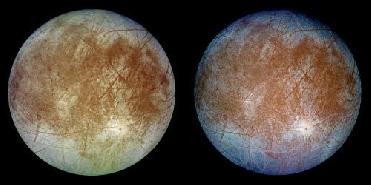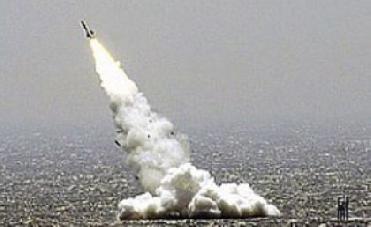
This image shows two views of the trailing hemisphere of Jupiter's ice-covered satellite, Europa. NASA photo
WSHINGTON (BNS): US space agency NASA is planning to send a mission to study the icy crust of Jupiter's moon Europa.
It is assumed that the mission will unravel the mystery of strange creatures swimming in the alien waters of Europa Ocean. The Galileo spacecraft, which orbited Jupiter from 1995 to 2003, provided the closest view of Europa.
On the drawing board, NASA's aim is to send the Juno mission to Jupiter in 2011, but that spacecraft will only orbit Jupiter and will not study any of the giant planet's moons. The European Space Agency (ESA) has been developing a Jovian Europa Orbiter, but that mission is still in the early planning stages and does not have a projected launch date as yet.
The American space agency said researchers were planning to study the giant planet’s moon in greater detail. The Europa-Jupiter System Mission (EJSM) plans to send one spacecraft to orbit Europa and another one to orbit Ganymede, the other large moon of Jupiter that also may have a liquid ocean locked beneath an icy outer layer.
The scientists at NASA said EJSM would be a joint mission of NASA and the European Space Agency, with ESA in charge of the Ganymede orbiter and NASA directing the Europa orbiter. Working together, the two spacecraft would also be able to conduct limited studies of the large moons Io and Callisto, as well as the planet Jupiter.
Speaking about the instruments the Europa orbiter would carry, Brad Dalton at NASA's Jet Propulsion Laboratory (JPL) said it would include a camera, a spectrometer, and a powerful radar system. The radar would enable the spacecraft to peer through Europa's ice and figure out just how thick it is, he added.
The Ganymede orbiter would also carry a camera and spectrometer, as well as a dust analyzer, mass spectrometer or magnetometer -- instruments that could be used to study the surface composition of Ganymede and the surrounding space environment.
"The Ganymede orbiter will be more concerned with overall geophysical processes, from the interior to the magnetosphere. The Europa orbiter design is driven in part by the astro-biological significance of the Europa Ocean, so it will be focused more on direct evidence for the ocean and the tidal flexing that keeps it liquid," Dalton said.
The JPL scientist said researchers had planned to send a surface lander or even a submarine to investigate Europa's ocean, but the EJSM holds no such views. "We tried very hard, within our cost and mass constraints, to come up with a realistic lander concept. The truth is, for the amount of mass and cost it adds, it's very difficult to include sufficient scientific capability to make it worthwhile. Part of the problem is in understanding the surface well enough to constrain the design. Once you get there, of course you are going to want to dig -- and that is just outside of the current fiscal reality."
The scientist said they considered sending a probe that would slam into the ice at high velocity. Such an impactor could provide a lot of information about the composition of the icy shell – just like the impactor did for the Deep Impact mission to a comet. The orbiter itself even could act as the impactor at the end of the mission. "However, this brings up some nightmarish planetary protection issues."
"After a lot of discussion and brain-storming, it became clear that we really need to look before we leap. There is a lot we can do from orbit, (work) that needs to be done before we can send the kind of lander everybody seems to want." However, the scientist said sending a lander has not been ruled out. "There are some minimal instrument concepts still on the table, but nothing like a Viking or a Phoenix (lander)."
There were plans to send a seismometer, in order to get a sense of how much and how frequently the ice shifts on Europa, Dalton said, adding, the seismometer also could include a mass spectrometer to determine what sort of chemistry takes place within the ice.
Scientists believe that the mission could answer the question of whether there is life on Europa by analyzing the ice shell. "The underlying ocean on Europa occasionally wells up out of cracks in the ice shell and washes over the surface, erasing features like impact craters. If life is carried in these waters, then their remains could now be frozen in the ice and an orbiter could detect them."
Scientists said that the orbiter would have a tough time finding evidence for life if it is confined to the bottom of the ocean. They believe that the origin of life on Earth occurred at volcanic vents in the ocean and suspect Europa has similar volcanic activity, thanks to the gravitational influence of Jupiter, which squeezes Europa as it orbits from one side of the planet to the other.
“This tidal flexing should keep Europa's core molten and result in volcanic activity – just look at Europa's neighbour Io as an example. Io orbits even closer to Jupiter than Europa, and its surface is pockmarked with active volcanoes that spew sulphur and other chemical compounds into space. Many of these same compounds are found at Earth's hydrothermal vents, and may be associated with early life on the planet," the scientist said.
However, Dalton said even if EJSM doesn't find direct evidence of life on Europa, it may be able to determine whether the moon is generally conducive to life, as we know it. "If EJSM finds that Europa's environment is habitable then that improves our prospects for searching later with a landed system."
Even if EJSM determines that Europa is inhospitable to life or it is a dead moon, that still won't be the final answer about the possibility for life on Europa, Dalton said.
"As with Mars, where we have not yet found any evidence of life, there are still many ways life could exist there. EJSM will help us narrow down the possibilities so we know where to look closely. There is so much we don't know about Europa yet," the JPL scientist said.
However, no final decision has been taken on mission to Europa and competing with EJSM is TSSM, a mission to Saturn and its large moon Titan. A final decision is likely to be taken in early 2009 which meant that the projected launch date is around 2020, with an arrival around 2030, NASA said.
 Previous Article
Previous Article Next Article
Next Article













The Indian Air Force, in its flight trials evaluation report submitted before the Defence Ministry l..
view articleAn insight into the Medium Multi-Role Combat Aircraft competition...
view articleSky enthusiasts can now spot the International Space Station (ISS) commanded by Indian-American astr..
view article